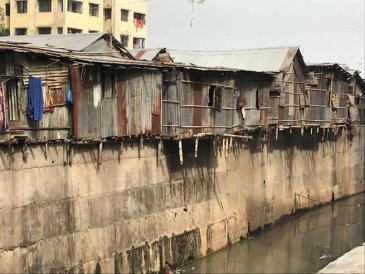
The City of Los Angeles- Photo: Ron Reiring / Flickr /CC BY 2.0.
The Human Security Link
The sustainability of cities depends on the human security of new migrant populations. Human security, in this context, means the ability and real prospect of living a meaningful life. A shorthand for human security is ‘freedom from want and freedom from fear’. Many migrant populations globally face significant insecurity in their material wellbeing as well as social exclusion and exposure to crime, environmental hazards and other dimensions of precarity. Freedom from want and fear encapsulates, therefore, many of these aspects of the human security challenge in growing cities.
Our hypothesis that sustainability of cities is related to the human security of migrants is based on two principal observations. First, it is the population dynamics of migration that drives urbanization processes in rapidly growing cities. Second, migrant populations are critical because they are potential agents of change, even in circumstances where they are economically and politically marginalised.
Do cities grow because of migration? The large majority of people currently living in the most rapidly growing cities, ranging from Lagos to Dhaka to Manila, were not born there, but they moved there either as individuals or with their parents. These people are known as lifetime migrants: up to ninety percent of the population of some large metropolises are in effect in this category. Population estimates of growing mega-cities across Asia and Africa have very significant uncertainty. Estimates come from decadal censuses and nightlight estimates, but are notoriously unreliable. In effect this is because migrants move to cities at rates that are difficult to measure. For Dhaka in Bangladesh, for example, population growth rates suggest that perhaps 1000 extra people arrive in Dhaka every day that were not there the day before.
Why are Migrants Critical to Sustainability?
Most domestic migration to cities from rural areas or smaller settlements across the world is in effect voluntary decisions taken by working age individuals, often in the context of family and households, to realise economic opportunities. They have much to gain from such moves. And they have much to gain from building communities in places they move to. But migrants tend not to have deep roots, and are often economically marginalised and discriminated against. As documented in greater detail here and here, migrants in low income neighbourhoods and slums have been shown to have poor health outcomes, increased incidence of chronic diseases, lack access to public space, and to preventative health care as well as clustering in places exposed to environmental hazards, from poor water quality, to risks from landslides and floods.
Observing Insecurity in Chattogram
Our research collaboration has focused on Chattogram, the second city of Bangladesh and its commercial and port hub. We have investigated the sources of human insecurity in migrant populations and engaged in action research on bringing new populations into planning processes. Chattogram has grown from approximately 1.5 million to approximately 5.5 million residents in the past generation. We have collected data using survey methods among new migrants from different populations, including ethnic minatory Chittagong Hill Tract people, focussing on how insecurity is manifest and how it affects their material wellbeing and their mental wellbeing. The core elements of human security in this context are captured in attachment to place, security and stability of sources of material wellbeing and employment; fear of violence and crime; and mental health outcomes. Our preliminary results show that key sources of insecurity include fear of eviction and other elements of precarity.
We have engaged with planners and migrant populations to attempt to build empathy between them. In effect we test whether integration is possible and what small steps can be taken to bring migrant perspectives into city planning. We gave cameras to a cohort of migrants and a cohort of planners with a simple instruction: take photos of what constitutes safety and sustainability for your lives. Each person took hundreds of photographs each, many with deeply held meaning and insight into their own lives and those of their neighbours, families and communities. And they explained these photographs through in-depth narratives that reveal the interactions between elements of precarity and stability.
We brought these two groups together to allow them to compare their stories and images, and to realise the similarities and resonance. In effect, taking the perspectives of each other built empathy between these groups. We believe the visual nature of the often overlooked elements of human security really helped to facilitate this process.

Precarious livelihoods and fear of eviction undermine human security of migrant communities. Bola slum, Dhaka. Photo: Neil Adger
Human Security and Urban Futures
Human security infuses the Sustainable Development Goal focused on urban settlements. But the dimensions of human security related to the urban experience can usefully be expanded, for example, to incorporate understanding to place attachment and the role of community resilience, and the impact of urban living on mental health.
It is often assumed that the challenge of sustainable urbanization rests with the planners of cities: those that decide on public infrastructure, on fiscal incentives for one type of development over another, or regulate zones for different land uses. Our work in Chattogram is revealing that participatory processes have the potential to incorporate perspectives of the lived experience of those new populations for whom the city is their future and indeed can reflect the lived experience of the planners themselves.
Migration flows to cities result from the myriad of individual decisions about where best to pursue one’s life. Such decisions are taken continuously across the world, and the reality of this fluidity and mobility needs to be part of the human security calculus.
Neil Adger is Professor of Geography at the University of Exeter, UK, and Principal Investigator of Safe and Sustainable Cities: Human Security, Migration and Wellbeing funded by the UK Economic and Social Research Council and Department for International Development. Chattogram migrant survey report.
Ricardo Safra de Campos is Research Fellow in Geography, College of Life and Environmental Sciences, University of Exeter, UK and co-Investigator of Safe and Sustainable Cities: Human Security, Migration and Wellbeing.
Tasneem Siddiqui is Professor in Political Science at the University of Dhaka, Bangladesh and Founding chair of the Refugee and Migratory Movements Research Unit. She is co-Investigator of Safe and Sustainable Cities: Human Security, Migration and Wellbeing.
This text was first given as a lecture at an event at the Department of Conflict and Peace Research, Uppsala University, organized in collaboration with the CLIMSEC project at PRIO, funded by the European Research Council. For a fuller conceptual discussion of the sustainability or migration, consult this PRIO report.
Leave a Reply